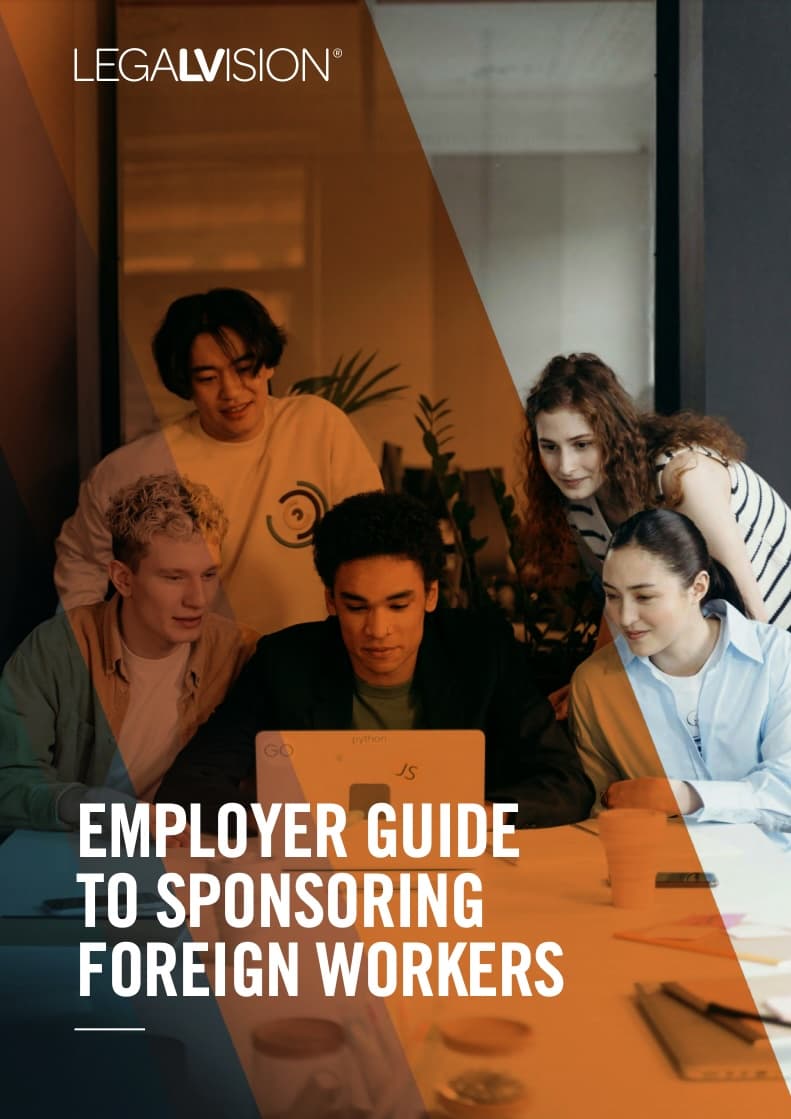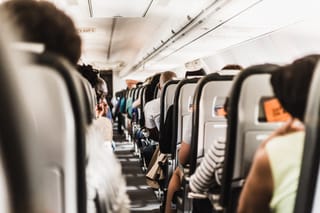In Short
- Businesses must complete three steps; become an approved sponsor, nominate the worker, and ensure the worker applies for the correct visa.
- There are different sponsorship categories: Standard, Overseas, and Accredited, each with specific criteria.
- Employers must comply with Australian laws and meet documentation requirements to maintain their sponsorship status.
Tips for Businesses
Ensure your business is legally compliant and prepared with all necessary documentation before applying to sponsor foreign workers. Understand your obligations under each visa subclass, especially regarding worker support and government regulations. This preparation helps avoid delays and maintain a smooth sponsorship process.
Table of Contents
- Three Stages of Employing Foreign Workers
- 1. Approved Business Sponsor for Foreign Workers
- How Can I Apply to Become a Sponsor?
- What Happens Once I Become an Approved Sponsor?
- 2. Your Business Must Nominate the Employee
- 3. The Employee Must Apply for the visa
- Key Takeaways
- Frequently Asked Questions
Australia’s ongoing skill shortage is leading businesses to rely more on foreign workers to fill the gaps. However, sponsoring a foreign worker is not straightforward significantly, since migration laws are constantly changing. If you are considering sponsoring an employee from overseas, it is crucial to understand which visas apply to your situation and your sponsorship obligations. This article will outline the process of sponsoring foreign workers, the visa options available, and the requirements you need to fulfil.
Three Stages of Employing Foreign Workers
To temporarily employ foreign workers, you must complete three stages:
- becoming an approved business sponsor;
- nominating an intended employee in the relevant occupation; and
- having the intended employee apply for a specific temporary visa.
It is worth noting that there are other strategies for employing sponsored workers, such as executing a Labour Agreement.
1. Approved Business Sponsor for Foreign Workers
Before you can sponsor an employee, you must apply to be an approved sponsor. There are three types of approved business sponsors:
| Standard Business Sponsor (SBS) | The proposed employer is based in Australia. This is the most common. |
| Overseas Business Sponsor (OBS) | The proposed employer is based overseas and wants to sponsor an employee to work in Australia for a particular role. Note: the employer can apply to be an SBS once an Australian branch of their business is established. |
| Accredited Business Sponsored (ABS) | The proposed employer is based in Australia, is already an approved SBS and meets the accreditation criteria. This enables extra benefits such as quicker processing times and more relaxed labour market testing requirements. |
To become a business sponsor, you can have any type of business structure as long as you meet the requirements. However, if your business structure changes (such as from sole trader to company) after you become an approved sponsor, you may need to re-apply for sponsorship.
Continue reading this article below the formHow Can I Apply to Become a Sponsor?
In order to become an approved business sponsor, you will need to make an application to the Department of Home Affairs. You will need to provide supporting documentation to demonstrate that your business meets the requirements.
To meet the requirements, you will need to demonstrate that your business:
- is legally established;
- is of good standing;
- complies with Australian laws (or the relevant laws in your country for OBS);
- is not subject to any adverse information; and
- is committed to employing local labour and will not engage in any discriminatory recruitment practices.
The supporting documentation you should attach to your application includes:
- Australian business number, Australian Securities and Investments Commission (ASIC) records, and registered business name;
- details of your company structure (e.g., trust, incorporated association, or unincorporated association);
- business activity statements, accountant letters, financial records, and business bank statements;
- organisational charts, employee records, payroll, employment contracts, and workplace policies;
- annual reports;
- if your business is a start-up, additional documents to demonstrate financial viability; and
- if your business is applying to be an OBS, additional information regarding the purposes of transferring your employees to Australia.
What Happens Once I Become an Approved Sponsor?
Once you successfully become an approved sponsor, your sponsorship remains valid for up to five years. This enables you to sponsor foreign workers through the relevant visa pathway.
As an approved business sponsor (SBS or accredited), you hold specific responsibilities to the Department of Home Affairs (DOHA) and the workforce you sponsor. If you fail to meet these obligations, DOHA may take various actions against you.
2. Your Business Must Nominate the Employee
Once your business becomes an approved business sponsor, you can nominate workers for positions you wish to fill. This process is subject to meeting the relevant requirements. Over time, the nomination process has become more comprehensive. Businesses must follow the appropriate procedures and requirements to receive a successful nomination grant.
The key temporary visa subclasses under which you can nominate an employee are:
Temporary Skills Shortage (TSS) subclass 482
This temporary visa allows employers to sponsor skilled workers to fill positions they cannot find skilled Australians for. It is a standard option.
Temporary Skilled Employer Sponsored Regional (Provisional) (SESR) subclass 494
This visa lets regional employers tackle labour shortages in their area by sponsoring skilled workers when they cannot find the right Australian worker.
During the nomination stage, you need to show specific crucial requirements to prove the job’s authenticity. Here are some key differences between the nomination stages for subclass 482 and 494 visas:
| Subclass 482 | Subclass 494 | |
| Skilling Australians Fund (SAF) levy | Paid per worker per year of sponsorship. | One-off fee. |
| Location | Anywhere in Australia. | Designated regional areas. |
| Occupation | Occupations must be selected from either the MLTSSL, STSOL or ROL. Caveats apply to some occupations. | Occupations must be selected from either the MLTSSL, STSOL or ROL. No caveats apply. |
| Labour market testing (LMT) | Yes, unless an international trade obligation (ITO) applies. | Mandatory. No exemptions apply. |
| Validity | Two to four years. Potentially longer if an ITO applies. | Five years. |
| Permanent residency | Available for all Subclass 482 visa holders, regardless of what stream they were nominated in. You can refer to our web article Expanding Permanent Residence Pathways to All 482 Visa Holders. | Via the 191 Visa. |
Skilling Australians Funds Levy
When you nominate workers under temporary and permanent employer-sponsored visas, you must pay a government tax levy. This levy, known as the Skilling Australians Funds (SAF) levy, contributes to the Skilling Australians Fund (SAF), a government initiative aimed at increasing the number of apprenticeships and traineeships in Australia. The amount you pay depends on your business’ annual turnover. You will provide this information along with your nomination application on your Australian tax return.
Labour Market Testing
Before you submit a nomination application, you need to conduct labour market testing unless you qualify for an exemption. The purpose is to show that no qualified Australian permanent resident or citizen is available for the job. You must meet specific requirements for conducting this testing. Some exemptions may apply, relieving you from this obligation.
Genuine Position
When nominating a foreign worker, the position linked with the nominated occupation must be genuine. You need to show that you are not just creating the position to facilitate the applicant’s migration process. This involves satisfying the Department of Home Affairs that there is a genuine need for the nominee to perform the duties of the eligible occupation within your company. You will need to provide details about your business, how the nominated position contributes to your operations, and why the role is vital. Typically, this involves submitting the following documentation:
- a summary of the business background and its core activities;
- evidence that your business is financially capable of supporting the nominee (noting that the evidence needs to be stronger if your business has been trading for less than 12 months);
- position description of the nominated position, including the purpose, duties, skills/qualifications/experience needed, and
- evidence of the nominee’s suitability for the position and the potential value they can bring if employed.
Australian Market Salary Rate
When sponsoring an overseas worker who will be paid an annual salary of less than $250,000, you must demonstrate the following:
- their salary is the same or above the current Temporary Skilled Migration Income Threshold (TMSIT). As of 1 July 2023, this is $70,000 plus superannuation; and
- their salary is equivalent to the salary that Australian citizens/permanent residents earn or would earn, based on the same arrangements (full-time, annual, same workplace, exact location, same level).
3. The Employee Must Apply for the visa
After you submit your nomination application, you can then proceed to submit the relevant visa application. At this stage, you will need to meet specific eligibility criteria tailored to you, the nominee. Below, we outline the main differences in visa criteria:
| Subclass 482 | Subclass 494 | |
| Skills assessment | Only required for some occupations. | Mandatory for all occupations. |
| Work experience | At least two years of full-time work experience in the last 5 years. | At least three years of full-time work experience in the last 5 years. |
| English requirements | English language competency depends on which stream the occupation falls in. | All applicants must obtain Competent English at the time of application. |
| Character requirements | Police checks are mandatory. | Police checks are mandatory. |
| Health requirements | Health checks are mandatory. | Health checks are mandatory. |
There are other requirements, including:
- you must not owe any debt to the Australian government; and
- you must not have had any prior visas cancelled, and must comply with all previous visa conditions.
Remember, even if your sponsorship and nomination applications are approved, the nominee cannot come to Australia and work for you if their visa application is refused. It is crucial to verify their eligibility before starting the nomination process.
Once the appropriate visa is granted, the employee can enter Australia and work for your business according to the visa conditions and your obligations as a sponsor.

Sponsoring overseas workers as an Australian business is complicated. Let us simplify it for you with this free employer guide.
Key Takeaways
The three stages of employing foreign workers are:
- becoming an approved business sponsor;
- nominating an intended employee in the relevant occupation; and
- having the intended employee apply for a specific temporary visa.
Each stage involves a comprehensive list of criteria that you will need to meet and demonstrate in your application, as well as provide the appropriate supporting documentation.
If you need help with sponsoring an overseas worker, our experienced immigration lawyers can assist as part of our LegalVision membership. For a low monthly fee, you will have unlimited access to lawyers to answer your questions and draft and review your documents. Call us today on 1300 544 755 or visit our membership page.
Frequently Asked Questions
To sponsor a foreign worker, you must complete three stages: 1) become an approved business sponsor, 2) nominate an intended employee for a specific occupation, and 3) have the employee apply for the appropriate temporary visa.
Businesses must show they are legally established, in good standing, compliant with Australian laws, not subject to adverse information, and committed to employing local labour without discriminatory practices.
We appreciate your feedback – your submission has been successfully received.











